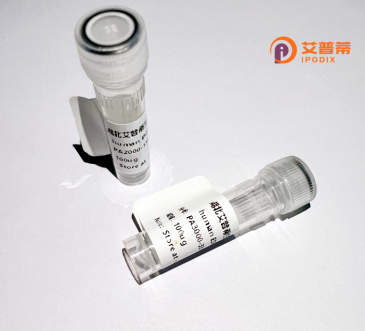
| 纯度 | >90%SDS-PAGE. |
| 种属 | Human |
| 靶点 | TUFT1 |
| Uniprot No | Q9NNX1 |
| 内毒素 | < 0.01EU/μg |
| 表达宿主 | E.coli |
| 表达区间 | 1-390 aa |
| 活性数据 | MNGTRNWCTL VDVHPEDQAA GSVDILRLTL QGELTGDELE HIAQKAGRKT YAMVSSHSAG HSLASELVES HDGHEEIIKV YLKGRSGDKM IHEKNINQLK SEVQYIQEAR NCLQKLREDI SSKLDRNLGD SLHRQEIQVV LEKPNGFSQS PTALYSSPPE VDTCINEDVE SLRKTVQDLL AKLQEAKRQH QSDCVAFEVT LSRYQREAEQ SNVALQREED RVEQKEAEVG ELQRRLLGME TEHQALLAKV REGEVALEEL RSNNADCQAE REKAATLEKE VAGLREKIHH LDDMLKSQQR KVRQMIEQLQ NSKAVIQSKD ATIQELKEKI AYLEAENLEM HDRMEHLIEK QISHGNFSTQ ARAKTENPGS IRISKPPSPK PMPVIRVVET |
| 分子量 | 44.2 kDa |
| 蛋白标签 | His tag N-Terminus |
| 缓冲液 | PBS, pH7.4, containing 0.01% SKL, 1mM DTT, 5% Trehalose and Proclin300. |
| 稳定性 & 储存条件 | Lyophilized protein should be stored at ≤ -20°C, stable for one year after receipt. Reconstituted protein solution can be stored at 2-8°C for 2-7 days. Aliquots of reconstituted samples are stable at ≤ -20°C for 3 months. |
| 复溶 | Always centrifuge tubes before opening.Do not mix by vortex or pipetting. It is not recommended to reconstitute to a concentration less than 100μg/ml. Dissolve the lyophilized protein in distilled water. Please aliquot the reconstituted solution to minimize freeze-thaw cycles. |
以下是关于重组人TUFT1蛋白的3篇参考文献及摘要概括:
1. **文献名称**:*Recombinant Human Tuftsin Upregulates TGF-β1 Expression in Hepatocytes and Attenuates Liver Fibrosis in Rats*
**作者**:Zhang L, et al.
**摘要**:研究通过重组TUFT1蛋白处理肝细胞,发现其上调TGF-β1表达,抑制肝星状细胞活化,并显著减轻大鼠肝纤维化程度,提示TUFT1可能通过调节TGF-β通路参与肝脏修复。
2. **文献名称**:*Expression and Purification of Functionally Active Recombinant Human TUFT1 in E. coli*
**作者**:Wang Y, et al.
**摘要**:该研究建立了一种高效的大肠杆菌表达系统,成功获得可溶性重组TUFT1蛋白,并通过质谱和体外钙结合实验验证其生物活性,为后续功能研究提供可靠工具。
3. **文献名称**:*TUFT1 Promotes Metastasis of Colorectal Cancer through TLR4/NF-κB Signaling*
**作者**:Chen H, et al.
**摘要**:利用重组TUFT1处理结肠癌细胞,发现其通过激活TLR4/NF-κB通路增强上皮间质转化(EMT),促进转移。动物实验证实TUFT1敲减显著抑制肿瘤转移。
提示:实际检索时建议结合PubMed或Web of Science平台,使用关键词"recombinant TUFT1 protein"+"human"进一步筛选近年研究。部分早期文献可能聚焦于TUFT1内源性功能,需注意筛选明确使用重组蛋白的实验研究。
Tuftelin 1 (TUFT1) is an acidic, cysteine-rich glycoprotein originally identified as a key component of the enamel matrix critical for tooth development. It belongs to the secretory calcium-binding phosphoprotein family and is evolutionarily conserved across vertebrates. TUFT1 is expressed not only in mineralizing tissues like teeth and bones but also in various epithelial and neural tissues, suggesting broader biological roles beyond mineralization. Structurally, it contains multiple functional domains, including a N-terminal signal peptide, a conserved tyrosine-rich acidic region, and a C-terminal domain involved in protein-protein interactions. Studies indicate TUFT1 participates in cell adhesion, signaling pathways, and tissue remodeling, potentially regulating processes such as cell migration, apoptosis, and extracellular matrix organization. Dysregulation of TUFT1 has been linked to pathologies including cancer, where it may act as an oncoprotein by promoting epithelial-mesenchymal transition (EMT) and metastasis. Recombinant human TUFT1 protein, produced via expression systems like E. coli or mammalian cells, enables functional studies to elucidate its mechanisms in development and disease. Its biochemical properties and interaction networks remain under active investigation, with potential applications in biomedicine, including diagnostics and therapeutic targeting.
×